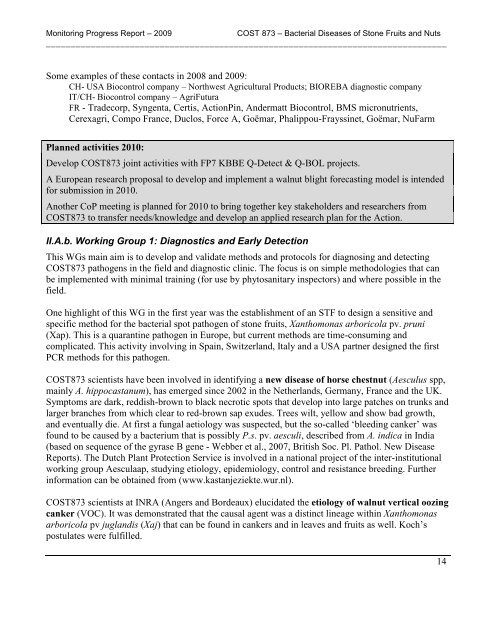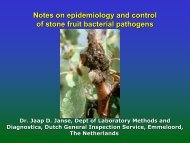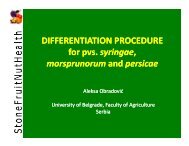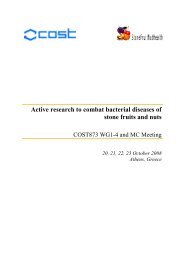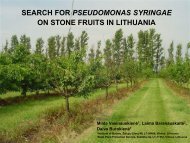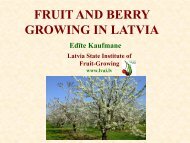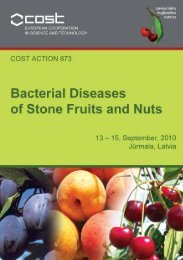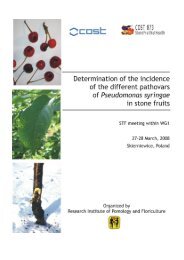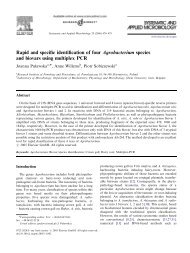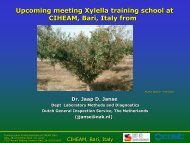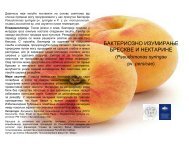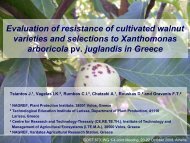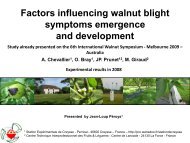Annual progress report - Cost 873
Annual progress report - Cost 873
Annual progress report - Cost 873
Create successful ePaper yourself
Turn your PDF publications into a flip-book with our unique Google optimized e-Paper software.
Monitoring Progress Report – 2009<br />
COST <strong>873</strong> – Bacterial Diseases of Stone Fruits and Nuts<br />
_________________________________________________________________________________<br />
Some examples of these contacts in 2008 and 2009:<br />
CH- USA Biocontrol company – Northwest Agricultural Products; BIOREBA diagnostic company<br />
IT/CH- Biocontrol company – AgriFutura<br />
FR - Tradecorp, Syngenta, Certis, ActionPin, Andermatt Biocontrol, BMS micronutrients,<br />
Cerexagri, Compo France, Duclos, Force A, Goëmar, Phalippou-Frayssinet, Goëmar, NuFarm<br />
Planned activities 2010:<br />
Develop COST<strong>873</strong> joint activities with FP7 KBBE Q-Detect & Q-BOL projects.<br />
A European research proposal to develop and implement a walnut blight forecasting model is intended<br />
for submission in 2010.<br />
Another CoP meeting is planned for 2010 to bring together key stakeholders and researchers from<br />
COST<strong>873</strong> to transfer needs/knowledge and develop an applied research plan for the Action.<br />
II.A.b. Working Group 1: Diagnostics and Early Detection<br />
This WGs main aim is to develop and validate methods and protocols for diagnosing and detecting<br />
COST<strong>873</strong> pathogens in the field and diagnostic clinic. The focus is on simple methodologies that can<br />
be implemented with minimal training (for use by phytosanitary inspectors) and where possible in the<br />
field.<br />
One highlight of this WG in the first year was the establishment of an STF to design a sensitive and<br />
specific method for the bacterial spot pathogen of stone fruits, Xanthomonas arboricola pv. pruni<br />
(Xap). This is a quarantine pathogen in Europe, but current methods are time-consuming and<br />
complicated. This activity involving in Spain, Switzerland, Italy and a USA partner designed the first<br />
PCR methods for this pathogen.<br />
COST<strong>873</strong> scientists have been involved in identifying a new disease of horse chestnut (Aesculus spp,<br />
mainly A. hippocastanum), has emerged since 2002 in the Netherlands, Germany, France and the UK.<br />
Symptoms are dark, reddish-brown to black necrotic spots that develop into large patches on trunks and<br />
larger branches from which clear to red-brown sap exudes. Trees wilt, yellow and show bad growth,<br />
and eventually die. At first a fungal aetiology was suspected, but the so-called „bleeding canker‟ was<br />
found to be caused by a bacterium that is possibly P.s. pv. aesculi, described from A. indica in India<br />
(based on sequence of the gyrase B gene - Webber et al., 2007, British Soc. Pl. Pathol. New Disease<br />
Reports). The Dutch Plant Protection Service is involved in a national project of the inter-institutional<br />
working group Aesculaap, studying etiology, epidemiology, control and resistance breeding. Further<br />
information can be obtained from (www.kastanjeziekte.wur.nl).<br />
COST<strong>873</strong> scientists at INRA (Angers and Bordeaux) elucidated the etiology of walnut vertical oozing<br />
canker (VOC). It was demonstrated that the causal agent was a distinct lineage within Xanthomonas<br />
arboricola pv juglandis (Xaj) that can be found in cankers and in leaves and fruits as well. Koch‟s<br />
postulates were fulfilled.<br />
14


